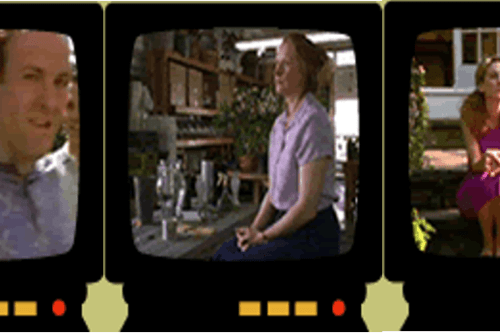No getting away from it: Claire Fisher (Lauren Ambrose) is one confused young woman. She takes drugs, is drawn to psychotically dangerous young men, pinches a severed cadaver foot to place in a classmate’s locker for lovelorn reasons, may or may not be an arsonist, drives around in that lime-green hearse (what’s that all about?), and has had an abortion. Critics share the opinion that she is acting out—a teenage rebellion put down to the sudden death of the father she had yet to know (Leonard 93; O’Hehir 6). Is it any wonder that the troubled adolescent from the Home Box Office (HBO) series Six Feet Under needs therapy? But are her “mistakes” Oedipal gaffes, or indicative of wider problems facing young women in a postfeminist, postpatriarchal world?
Sketched in this paper is how Six Feet Under comes to know Claire—represents her sexuality, labels her behavior—through therapy, as well as her attempts to resist subjection. It is no small coincidence that Claire is obliged to explain herself in a professional counselor’s office at the moment she loses her virginity. Such an event may at first be accompanied by a fantasy song-and-dance routine, where our recently deflowered maiden muses on “What a Little Moonlight Can Do” (a great deal apparently), but she now becomes ensnared in “clandestine, circumscribed, and coded types of discourse” (Foucault 4). Despite the series’ general candidness about bodies, female sexuality remains shrouded in taboo and silence. Underlying my argument here is the notion that the series produces a contradictory female subject—between introducing insurgent identities while revealing how modern American Puritanism imposes its rules on the feminine—which it embeds right into its dramatic structure. Other confessional television formats such as daytime talk-shows are appropriated along with the American rewriting of Freud’s “talking cure” (taking such forms as self-help, self-actualization, 12-step revisions, and counseling) that privileges individual self-knowledge over patriarchal authority (Starker). Just as the series confronts us “with the departure of the father who seems to bear the phallus” (Tobin 87), Six Feet Under draws on the individual-oriented therapies made popular during the anti-authoritarian post–World War II period (Shattuc 114)—therapies that transferred agency from expert to patient (Miller). Such discourses proliferated as postwar American society busied itself with challenging the patriarchal order—through Vietnam War protests; emancipatory movements such as second-wave feminism, and gay and civil rights; and a counterculture defined by popular music, New Age philosophies, and experimentation in the arts. As a product of this history, Six Feet Under is saturated with these anti-authoritarian social rules and cultural values, but, like American culture itself, the show does not embrace them fully. Simply put, Claire remains enclosed in power relationships—the family, the therapist couch, the Six Feet Under narrative structure—that compel her to endlessly talk about her sexuality, justify her behavior, and communicate her most intimate feelings.
Seasons 1 and 2 find Claire seeing the school guidance counselor, Gary Deitman (David Norona). She is initially sent to him to explain why she put a corpse’s foot in a classmate’s locker (“The Foot,” episode 3). Her justification of “protesting Footlocker’s inability to sell a decent-priced sneaker” appeases no one. But Claire’s presence in this clinical space reveals how female behavior bears the taint of abnormality and is labeled dysfunctional precisely because the clinical (male) space of the counselor’s office defines it as such. Julia Sherman detailed back in 1975 the ways in which psychoanalysis proved detrimental to female patients: from promoting “dependency and mystification [and] locating the problem and the blame within women” to “providing a negative view of women [and] handy rationales for the oppression of women” (Sturdivant 52). Is it any wonder that the series’ other female patient, “Charlotte,” a fictionalized version of Brenda as a child (Rachel Griffiths), resorts to barking at her therapist; or that Claire is often reduced to a sulky silence?
Michel Foucault describes “the confession [as] a ritual of discourse in which the speaking subject is also the subject of the statement” (61). Modern times find confessional techniques appropriated by disciplines like psychoanalysis in which truths related to Oedipal desire and libidinal drives are central to eliciting essential truths about the self. Yet, as Foucault further postulates, such presentations of self unfold “within a power relationship,” in which “the authority who requires the confession, prescribes and appreciates it and intervenes in order to judge, punish, forgive, console, and reconcile” (61–62). If Foucault is to be believed, then Claire’s guidance counselor Gary is there to infer meaning, to solve dilemmas and heal familial rifts. Immediately Gary asserts his dominance, making known that interpretative power resides not with the one who speaks but “the one who listens and says nothing” (Foucault 62), by inviting her mother (Frances Conroy) along to join them (“An Open Book,” episode 5). Claire has no say in the matter—”I told her it wasn’t my idea.” Gary deciphers for Ruth the reason for Claire’s unhappiness—that she missed out (but more on that later). Claire stops him: “No, you said that. I told you I don’t think there was a time when this family was ever happy.” Ruth and Claire start bickering while Gary sits back to listen (a virtual position shared by the viewers). Letting the women exhaustively rehearse their complaints reveals certain truths about this mother-daughter alliance. But Ruth and Claire emerge as exhibiting “signs of distress and mild clinical depression” (Ball and Poul 144) precisely because what they say is read as troubling and difficult by the secular interlocutor who desires to bring about an emotional adjustment and modify female behavior.



